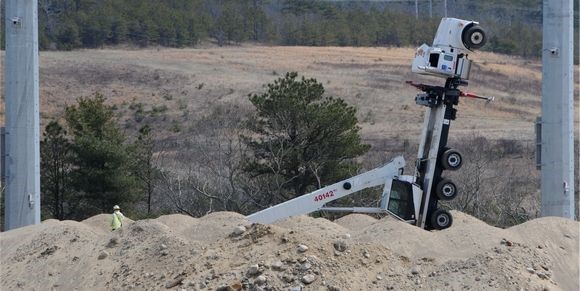
How do you think this crane ended up in this position’

Most’if not all’of the machinery and equipment used in the workplace comes with instructions from the manufacturer on how those devices should be used. Ignoring those instructions can not only damage the equipment but also put workers at risk.
These pictures from the Cape Cod Times in Massachusetts show the aftermath of a tragic incident in which two workers died. They were working on overhead power lines from a raised platform attached to the crane. The boom fell to the ground, flipping up the truck.
OSHA investigated the incident and concluded that it could’ve been prevented if the employer had set up and operated the crane according to the manufacturer’s instructions. Specifically, supervisors at the job site didn’t follow the procedures for setting up and operating the crane spelled out in the crane’s safety manual’even though the manual was in the crane and at the job site.
Similar incidents caused by ignoring manufacturer’s instructions have happened in Canada, too.
Example: A small family farm in Ontario used a sweep auger in a dryer bin. One end of the sweep auger was fixed in the centre and the other end moved in an arc across the floor, moving soy beans to the center. According to the auger’s operating manual, no one should enter the bin unless the power to the auger was disconnected and locked out.
But a worker swept beans into the bin while the auger was rotating. His clothing got tangled in the auger and he was thrown forward into its path. One of his legs got caught under the auger and suffered a laceration and soft tissue damage. The farm pleaded guilty to failing to comply with the manufacturer’s instructions for safe operation of the auger and was fined $18,000 [Willow Hawk Farms Inc., ON Govt. News Release, July 30, 2014].
SOURCES OF SAFETY REQUIREMENTS
When it comes to ensuring the health and safety of workers, there are three main sources of safety requirements:
- The OHS laws
- Any voluntary standards, such as those from the CSA, that have been adopted by the OHS laws
- The instructions from the manufacturers of equipment or machinery. Because these instructions are specific to the operation of that particular make and model of equipment, they provide important information on its safe use.
That’s why the OHS laws may, in fact, require you to comply with manufacturers’ instructions. For example, Sec. 12(d) of Alberta’s OHS Code 2009 says an employer must ensure that equipment and supplies are erected, installed, assembled, started, operated, handled, stored, serviced, tested, adjusted, calibrated, maintained, repaired and dismantled in accordance with the manufacturer’s specifications or the specifications certified by a professional engineer.
It’s especially important to comply with all of the requirements from all applicable sources when using particularly hazardous equipment, such as cranes and other lifting devices. Errors when using such machinery are more likely to have tragic consequences’and often involve more than one worker’than equipment such as hand tools.
7 KEY ELEMENTS OF LIFTING DEVICE REQUIREMENTS
The requirements in the OHS regulations for safe use of cranes, hoists, etc. typically cover seven key areas:
- Design and construction
- Load capacities and load charts (see, overhead crane lift calculation form)
- Inspections of the devices (see, tower crane weekly and monthly inspection form)
- Log books
- Training of lifting device operators. For example, in OSHA’s investigation of the Cape Cod incident, it found that workers weren’t properly trained or evaluated on this truck-mounted crane prior to use.
- Use of devices. For example, OSHA also found that supervisors didn’t conduct proper pre-lift planning and other required tests to ensure that the work could be done safely.
- Repair and maintenance.
10 RULES FOR SAFE USE OF LIFTING DEVICES
Here are 10 basic rules workers should follow for the safe use and operation of lifting devices, such as cranes and hoists:
- Operators shouldn’t leave a lifting device unattended when a load is suspended from it.
- Ensure that safe work procedures for work around overhead power lines are followed when there’s a risk a lifting device could come into contact with such lines.
- When the movement of a load could endanger others, use tag lines, guide ropes or clamps to control it.
- When traveling with a load, the operator should ensure it’s carried as close to the ground as possible.
- Workers shouldn’t ride on a load, hook, rigging or bucket attached to a lifting device.
- Make sure to implement appropriate traffic safety measures, such as signs, barricades or flaggers.
- Ensure lifting devices have audible warning signals to alert workers to lifting operations.
- Ensure that the wind or other weather conditions won’t impact the lifting of a load or make it hazardous.
- Protect the operators of lifting devices from hazards, such as falling or flying objects or material and extreme cold or heat.
- The load must be safely landed and supported before it’s unhooked from the lifting device.
